Le Bastion in the Corbières

An ambitious new addition in the hills of the western Languedoc. A version of this article is published by the Financial Times.
The village of Lagrasse in the foothills of the Corbières mountains in south-west France has drawn visitors since its renowned church was built in the 14th century. There are now other attractions: the Orbieu River for summer swimming, and the various shops, principally pottery and jewellery, that have emerged. Such are Lagrasse’s attractions that finding a place to park is inevitably the hardest challenge.
On the early evening we visited recently, all three designated car parks were full, as were the cafes and restaurants that spilled out onto the main street in the sunshine. We were extremely fortunate to find somewhere to park, albeit creatively.
Our goal was Le Bastion, a restaurant on a corner at the southern end of the main street lined with outdoor cafes. It brands itself ‘Avant-Garde Rurale’, a claim that could easily go one of two ways: either the restaurant could be extremely exciting or utterly pretentious.
The fact that Le Bastion falls firmly into the former category lies in its origins and the friendship forged more than a decade ago at Perpignan culinary school between then two aspiring young chefs, Fabien De Bruyn and Valentin Renaud. They have both recently turned 30.
After culinary apprenticeships around France for both of them, De Bruyn felt the pull of Lagrasse, where he had grown up, and its proximity to so much good produce – as well as the obvious challenge of establishing a restaurant that could enhance the reputation of the whole region. Four years ago the pair saw the space that was to become Le Bastion, their stronghold.
‘It was a complete ruin then’, De Bruyn confessed, ‘but we managed to create what you see today relatively inexpensively, for €100,000, and relatively painlessly.’
What has emerged is a ground-floor kitchen, behind which seven chefs work cheek by jowl, with a couple of tables opposite. In front is a coffee machine and the all-important reservations book and la caisse. All the other (well-spaced) indoor tables are upstairs in the high-ceilinged room shown above, although there is also a roadside terrace for when the weather permits.
This upper room is reached from the kitchen via a curved set of steps that are stone, thick and numerous – I counted at least 25. That is the only way up for every plate of food, and the only way down at the end of each service as well as for every bottle of wine, for every aperitif. This consideration has to affect the design of each and every dish.
The chefs’ strategy for overcoming this inconvenience is obviously to put a great deal of thought into each dish and to keep the choice relatively straightforward. But they eschew a simplistic approach.
There is a six-course ‘blind’ tasting menu (€62), plus two choices at each course on the à la carte three-course menu (€34) which all five of us chose. We were impressed by the virtuosity and creativity on offer.
The key to understanding these dishes, I realised in retrospect, is to appreciate the second half of each dish’s descriptor as much as the first, primary ingredient. So one first course that began with local Charentais melon came alive when it had been barbecued with the addition of local goat’s cheese, Szechuan pepper, a carrot, orange and ginger sorbet and some local herbs. The other first course, intriguingly named ‘as at Termonde’ (after the Belgian city where De Bruyn’s father was born and where they cook a similar dish with eel) was a colourful combination of hake, caviar and a devilled egg.
It was the quality of the principal ingredients that stood out in the main courses. The fillet of beef was first class and only enhanced by melting potato gnocchi inside a crisp coating, but it was the fish dish that really impressed me. Two fillets of red mullet alongside what was described as a reinterpretation of ‘pieds paquet’, the French dish that more usually consists of inexpensive cuts of lamb. Here a stuffed, small aubergine sat under the backbone of the red mullet, which had been cleverly deep fried: crisp and unctuous and best enjoyed with one’s fingers.
How they would manage a meringue-based vacherin up all these stairs intrigued me from the moment I saw it on the menu but again it was the engineering of this dish which added another level of excitement. There was a mountain of meringue whose base was a verdant, fresh basil pesto and all was held in place from underneath by a lemon sorbet: a combination that proved ingenious and delicious.
We drank as well as we ate. The surrounding Languedoc countryside offers a vast array of inexpensive, well-made wines of every colour and style and from their wine list we enjoyed an exciting Grenache Gris 2019 from Les Clos des Pères in La Livinière (€25) and the mature but still fresh Campagne des Centeilles Cinsault 2015 (€26) from Clos Centeilles, contributing not too much to a bill of €241. The meal was marred only by the nervousness of our young waiter, but this is presumably a reflection of the current world shortage of hospitality staff.
Le Bastion is a restaurant that I will happily return to. But I would choose a completely different season. I would go back in February when, according to De Bryun, the game, mushrooms and truffles are unmissable. He added invitingly, ‘I am completely obsessed with truffles…’.
Le Bastion 50 Boulevard de la Promenade, 11220 Lagrasse; tel: +33 (0)4 68 12 02 51
Become a member to view this article and thousands more!
- 15,423 featured articles
- 274,424 wine reviews
- Maps from The World Atlas of Wine, 8th edition (RRP £50)
- The Oxford Companion to Wine, 5th edition (RRP £50)
- Members’ forum
- 15,423 featured articles
- 274,424 wine reviews
- Maps from The World Atlas of Wine, 8th edition (RRP £50)
- The Oxford Companion to Wine, 5th edition (RRP £50)
- Members’ forum
- Commercial use of our Tasting Notes




